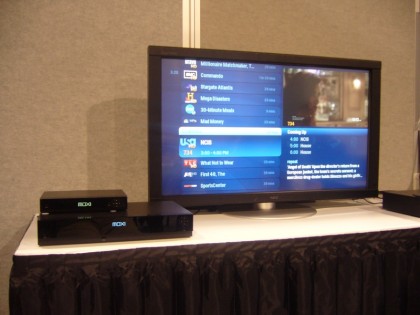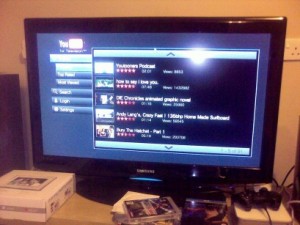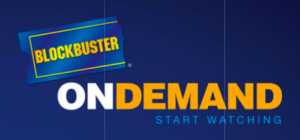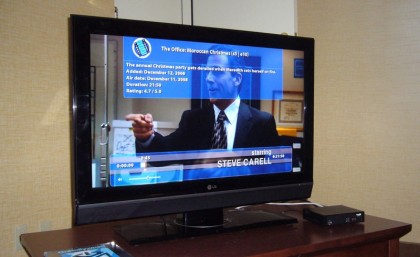A periodic roundup of relevant news from our friends at Zatz Not Funny…

Dave Zatz: Although units began shipping in mid-December (with little fanfare), Digeo CEO Greg Gudorf officially unveiled their long delayed and re-imagined retail Moxi HD DVR ($800) last week at CES. I’ve previously been critical of Digeo’s go-to-market and press/blogger outreach strategies, but I’ve never had a problem with their tech – in fact, the Moxi OS was ahead of it’s time.
Dave Zatz: The Sling booth was my first stop at CES, yet I managed to walk right by the one real surprise. Sling’s 15″ WiFi monitor displays (only) streamed video from a “SlingLoaded” DISH ViP 922 DVR within the home. Sort of a SlingCatcher, without additional media adapter functionality.
Wi-Fi photo frame the new Trojan Horse?
Mari Silbey: While gaming consoles are still attempting to make good on their role as Trojan Horse in the living room , I have a new candidate for the job: Wi-Fi photo frames. As ridiculous as that sounds, a WI-Fi photo frame is really nothing more than an IP-based display, capable of receiving IP-based content.
Dave Zatz: Not only did we witness a temporary cease fire in the “World’s Largest” flat panel CES showdown, a few other technologies played it low-key in Vegas…
 Perhaps taking a leaf out of the
Perhaps taking a leaf out of the 
 In a bid to play catch up with the likes of Apple, Netflix, Sony and Microsoft, video rental chain Blockbuster has signed a strategic partnership with Sonic Solutions, owners of the video download store CinemaNow. The move is designed to accelerate the company’s move into online video by pooling the two companies’ digital movie libraries, as well as tapping into CinemaNow’s existing ecosystem of supported devices, which includes portable media players, Blu-ray Disc players, personal video recorders (PVRs), set-top boxes, mobile phones and Web-connected television sets.
In a bid to play catch up with the likes of Apple, Netflix, Sony and Microsoft, video rental chain Blockbuster has signed a strategic partnership with Sonic Solutions, owners of the video download store CinemaNow. The move is designed to accelerate the company’s move into online video by pooling the two companies’ digital movie libraries, as well as tapping into CinemaNow’s existing ecosystem of supported devices, which includes portable media players, Blu-ray Disc players, personal video recorders (PVRs), set-top boxes, mobile phones and Web-connected television sets.  A report on Macrumors (my favourite Apple rumor site) observes that the company appears to have relaxed its iPhone App Store policy in relation to third-party web browsers. It was thought that, until now, competitors to Apple’s own Mobile Safari weren’t being approved on the basis that they “duplicate functionality” or compete with Apple’s own offering. That may no longer be the case.
A report on Macrumors (my favourite Apple rumor site) observes that the company appears to have relaxed its iPhone App Store policy in relation to third-party web browsers. It was thought that, until now, competitors to Apple’s own Mobile Safari weren’t being approved on the basis that they “duplicate functionality” or compete with Apple’s own offering. That may no longer be the case. DivX looks set to continue to be the video format of choice for ‘grey’ content, with the company announcing that version 7 adds support for H.264 video and, more significantly, the Matroska (MKV) container.
DivX looks set to continue to be the video format of choice for ‘grey’ content, with the company announcing that version 7 adds support for H.264 video and, more significantly, the Matroska (MKV) container.
 I didn’t get around to posting yesterday because, in all honesty, I spent most of the day scouring YouTube and various blogs for video coverage of the Consumer Electronics Show. In particular, I was keen to take in as many hands-on demos of the new Palm Pre and the accompanying webOS.
I didn’t get around to posting yesterday because, in all honesty, I spent most of the day scouring YouTube and various blogs for video coverage of the Consumer Electronics Show. In particular, I was keen to take in as many hands-on demos of the new Palm Pre and the accompanying webOS.